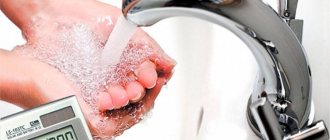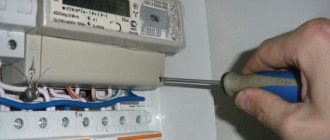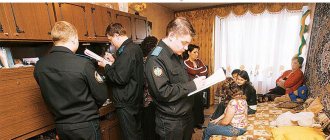Law
The main regulatory document regarding water supply and sanitation of houses is Federal Law dated December 7, 2011 N 416-FZ. It regulates the procedure for providing services to the population and organizations by relevant companies.
This law regulates the following principles and objectives within the framework of water supply and disposal:
- powers of government authorities at all levels in this matter;
- the procedure for supplying hot and cold water and its disposal;
- ensuring and monitoring the quality of supplied water;
- principles of environmental conservation in this field of activity;
- regulation of the application of tariffs.
The procedure that public utilities follow when providing services to the population is prescribed in the Rules approved by Decree of the Government of the Russian Federation No. 354 of 05/06/2011. It also defines services for the supply and disposal of water to apartment buildings and private buildings.
Drainage Law
In 2011, Russia adopted a law regulating the activities of companies providing utility services, in terms of supplying citizens with cold and hot water, as well as sanitation.
The Law on Drainage and Water Supply (Federal Law No. 416) regulates the following points of legal relations in the field of water supply and drainage:
- Standards for the implementation of services provided in this area (Chapter 3);
- Code of Practice relating to environmental protection in the field of wastewater disposal (Chapter 5);
- General system, methods and methods for calculating tariffs for payment of services depending on the parameters of organizations carrying out this activity (Chapter 6).
Drainage - what is it on the receipt?
Nowadays, many people monitor their utility bills and navigate calculations and concepts. Let us clarify what the lines in the receipts mean that are associated with such an important resource for us as water. Its consumption by each of us is divided into two concepts:
- Water supply . This is the water that is supplied by the utility supplier to the systems of an apartment building; it runs from our taps. According to the regulatory document, a round-the-clock uninterrupted supply of both cold and hot water of proper quality must be ensured. This means that purified water that meets the standards must flow from the taps in the living area. The temperature of the hot water supply is also established by the standards and must be supplied no lower than their values (water heating is highlighted on the receipt as a separate line).
- Water disposal . The received water is used and then transported through the sewerage system. The law gives the concept of this process, which includes the reception of wastewater, transmission through centralized sewerage systems to treatment facilities and their subsequent treatment (clause 2 of article 2 of Law No. 416-FZ).
Balance of water consumption and wastewater disposal methods of calculation, purpose and objectives
The content of the article
Owners of autonomous houses, members of housing complexes and full owners of apartments who do not have meters and enter into a contractual relationship with a contractor will receive a completely different answer to the question of calculating drainage. The final value for payment in these cases will be considered to be the standards specified by local organizations, which were calculated on the basis of average statistical information on water consumption in a certain region. The established value is recalculated every year, updated and communicated to the public through local media.
Water supply and wastewater systems, as well as their preliminary design, start from scratch for each site. Not only the specifics of the object, the area where it is located, but also the personal wishes of the developer must be taken into account. Attention is paid to such details as the purpose of the room, the number of future users of the system, the minimum and maximum amount of water that is supposed to be used. The water consumption balance includes absolutely all water flowing through pipelines: technical, waste, waste, drinking, precipitation, water for outside work.
Are drainage and sewerage the same thing?
Not everyone knows that drainage and sewerage are different concepts! Those homeowners who do not pay for sewerage are acting illegally, believing that it is the same thing. Let's find out if this is true.
What does drainage consist of?
Disposal of water used for the needs of apartment buildings and private buildings is an important event, consisting of:
- drainage of domestic wastewater from residential and non-residential premises through centralized sewer networks, which must be carried out around the clock;
- transportation of wastewater to treatment facilities;
- passing through a cleaning and disinfection system with subsequent use for technical purposes or discharge into natural bodies of water.
Conclusion: All sewage is removed from the house by drainage, then it is cleaned, and only then collected in the sewer and transported. In order for all systems to work efficiently and uninterruptedly, it is necessary to constantly maintain them in normal working condition. And this requires certain financial costs, which are covered by resource consumers.
How is it paid?
Many apartment buildings are serviced by management companies that enter into agreements with water supply and sanitation service providers. Therefore, they calculate the fee for each specific apartment and display the amount on the receipt. Owners of private houses independently enter into contracts with the resource supply organization if the house is connected to centralized water supply and sewerage networks.
Service fees are charged by the management company on a monthly basis. It depends on the amount of water consumed according to the meter or, in the absence of a meter, according to the standard. For the calculation, the volume of cold and hot water is taken. The same number of cubic meters should go into the sewer.
Good to know: How to apply for and calculate a subsidy for housing and communal services?
Calculation examples
In many apartments and private houses, meters for metering consumed resources are already installed. Therefore, the starting point for calculating the consumed water that must be disposed of is the water meter readings.
WATER DISPOSAL = (DHW + cold water) × TARIFF
Since the payment for hot water supply consists of the consumed volume of cold water and its heating, in receipts you can see lines such as:
- cold water supply - the number of cubic meters of cold water according to the meter;
- water heating - only that volume of hot water supply (m3) that is taken from the meter reading (IPU).
Example. At the end of the month, readings were taken from water meters in the apartment of citizen M:
- cold water - 10 cubic meters;
- DHW - 3 cubic meters.
In total, 13 cubic meters of water were consumed, which had to be diverted.
The tariff for these purposes is set at 25 rubles in the receipt: (10 + 3) × 25 = 325 rubles.
You should pay attention to the coincidence of the consumed and allocated volume. If a difference is noticed, you need to contact the management company for clarification as to why this happened.
How to calculate water drainage using a meter: formula and example
If you don’t trust online calculators or just want to understand how the amount to be paid is formed, then calculate it manually. To calculate water drainage from a meter, you need to use a special formula:
SV = (DHW + cold water) x TV, where
SV – total amount to be paid; DHW – monthly consumption of hot water, based on the readings of the IPU, m 3; Cold water consumption - monthly consumption of cold water according to the meter, m 3; TV – regional tariff.
This calculation is regulated by the Government Decree “On the procedure and conditions for citizens to pay for housing and utilities.” The regional tariff for each subject of the Russian Federation is individual.
For example, let’s calculate the cost of the service in Moscow. The local regional tariff (TV) is 21.90 rubles/m 3 . The consumption indicator for the month according to the meter is 10 cubic meters of cold water and 5 cubic meters of hot water. The total consumption of hot and cold water supply is 15 m3.
Substituting known values into the formula, we get:
(5 + 10) x 21.90 = 328.5 rubles.
The owner must repay such an account by the 20th of the next month.
If your sewer payment is late, the city water utility will issue a fine. If repayment of the debt is delayed, the organization will consider that its rights have been violated. Penalties will be accrued daily.
For those who do not want to calculate water drainage by meters themselves, there are specialized portals where you only need to enter the readings. Next, the system will display the amount to be paid.
In case of any controversial situations, you must immediately contact the Management Company for clarification. For example, if after an independent calculation it turns out that the resulting amount is less than that calculated by the city water utility. There have often been cases when employees of the Criminal Code took advantage of the inattention of conscientious citizens and entered increased testimony.
Water disposal at ODN in 2021
Residents of apartment buildings are also required to pay for such expenses as general house needs. If a collective metering device for water disposal is installed in the house, then it is easy to measure the difference by its readings and the drainage of water from apartments supplied by individual metering devices.
If such a deviation is present, then this will be one. Needs are distributed to each apartment in proportion to its area in the total volume of premises of the house.
If a device that specifically takes into account water drainage is not installed in an apartment building, then residents are not required to pay for the ODN for this item. This is due to the fact that standards are not established here, and therefore there is no calculation procedure.
How to control the accrual of wastewater disposal?
Calculation according to standards means that certain average values per person are used, which are accepted by local authorities. In this case, it does not matter at all how much water was actually diverted. Therefore, in some cases it is more profitable to use special accounting devices. In apartment buildings, communal meters are most often used.
To ensure that the management company does not overcharge, residents are advised to first check the values indicated on the receipt with the actual volume of wastewater disposal before paying. If a tenant or homeowner suddenly discovers that the numbers do not match, he has the right to file a lawsuit against the management company.
By law, all residents of an apartment building in which communal meters are installed have the right to access information about water consumption, but in this situation it is impossible to calculate from which specific apartment how much is allocated. This can only be found out by using individual metering devices.
What to do if there is no meter?
The simplest and most economical way to account for water consumption is to use individual meters. But not all residential premises or private households have them installed yet. For such residents, approved consumption standards are applied, according to which calculations and wastewater disposal are carried out. They are enshrined in regulations of local authorities. These standards far exceed the figures that reflect the actual volumes of resource used.
To know how much to put in a receipt for a given resource, the following criteria are taken:
- the number of persons living in this living space;
- average standard water consumption in cubic meters per person;
- tariff established by local authorities for 1 cubic meter of wastewater disposal.
By multiplying all three indicators, you get the amount that will be reflected in the receipt for utilities for this item.
Standards are constantly being revised upward, which encourages the population to install individual meters.
Also read: Is it necessary to install a water meter in 2021?
Rates
It is legally determined that tariffs for sewerage and water supply are set by local governments for the calendar year.
Their value depends on a number of criteria:
- how worn out the sewer system is, with plans for its partial modernization or ongoing repairs;
- condition of wastewater treatment facilities;
- other factors related to the availability of maintenance personnel and emergency crews.
Standard tariff values are freely available, and you can check them with the local administration or management company. Approved for residents of apartments where there are no meters.
For example, tariffs in 2021 excluding VAT were:
| City | Tariff, rub. |
| Moscow | 30,90 |
| Saint Petersburg | 32,53 |
| Sevastopol | 29,27 |
| Novosibirsk | Gorvodokanal - 15.08, Lozhok - 61.81 |
| Omsk | 20,93 |
| Samara | 19,30 |









